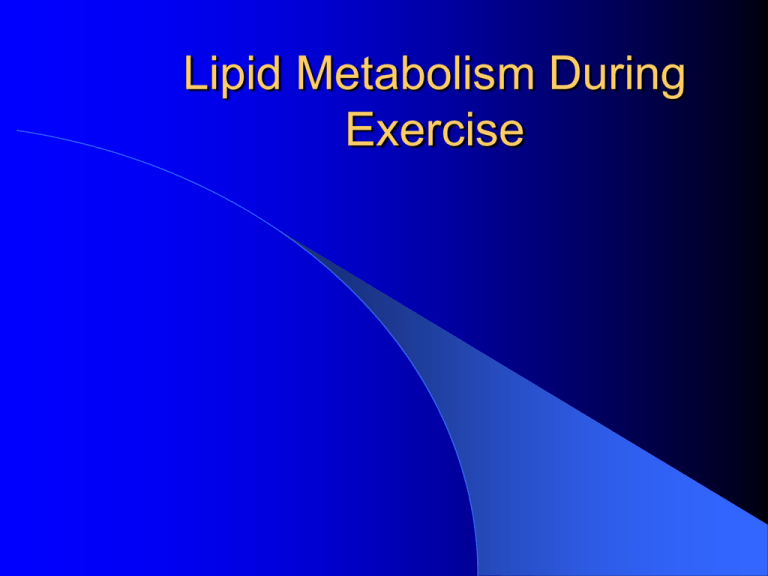Lipid Metabolism
advertisement

Lipid Metabolism During Exercise Plasma Free Fatty Acid Metabolism Plasma FFA during exercise result primarily from mobilized lipid stores in adipose tissue Adipose tissue is the most important store of energy in mammals – % body fat typically 10 – 25 % FFA Mobilization FFA mobilization is dependent upon i) Rate of lypolysis in the adipocyte ii) plasma transport capacity of FFA iii) rate of reesterification of FFA Conversion back to triglyceride Lipolysis Estimated by measuring glycerol in the plasma Glycerol appears in the plasma only as a result of lipolysis Cannot be reused by the adipocyte once liberated (glycerol kinase) A Quick Note About Lipogenesis Glycerol 3-P is used as the triacycl glycerol backbone (Houston fig 10.6) Glycerol 3-P derived from dihydroxyacetone phosphate (from glycolysis) Glycerol cannot be converted to glycerol 3P in the adipocyte Can also use appearance of FFA as estimate of lipolysis This is balance between lypolysis and reesterification (TG formation) – FFA can be used by adipocyte to form TG Gives the NET lipolytic rate Acute Exercise In general lipolysis is increased with exercise In isolated gluteal adipocytes – Following 30 min of cycling, catecholamine – stimulated glycerol release was ^ 35-50 % compared to pre-exercise Using microdialysis probe (in vivo measurement) during 30 min cycling – Glycerol release from abdominal adipocytes was increased Typically, in animals and humans, glycerol release increases 4-5 fold in prolonged moderate intensity exercise (3 – 4 hr) Hormonal Regulation Two most important hormonal regulators are catecholamines and insulin Catecholamines typically stimulate lipolysis Insulin stimulates lipogenesis and inhibits lipolysis Hormonal Regulation During Exercise -adrenergic activity is inhibitory -adrenergic activity is stimulatory At rest -adrenergic activity inhibits activation of lipolysis During exercise -adrenergic activity stimulates lipolysis How do we know? Phentolamine (-adrenergic blocker) doubled glycerol concentration in resting humans – Increased lipolysis Propanolol (-adrenergic blocker) did not alter glycerol concentration During Exercise Propanolol reduces the exercise induced elevation of glycerol by 65% – Also impairs endurance performance Phentolamine has no effect Insulin Insulin levels are decreased during exercise – Directly related to work intensity – Mediated by -adrenergic inhibition Fasting, fat-feeding and insulin deprivation in diabetics result in elevated FFA and glycerol in plasma Hormone Sensitive Lipase Hormones regulate lipolysis via their effects on hormone sensitive lipase (HSL) – HSL hydrolyzes FFA from glycerol backbone HSL is regulated by its phosphorylation state Phosphoylation of the regulatory site activates lipolysis Insert Fig 10.8 http://www.kumc.edu/research/medicine/biochemistry/bioc800/lip01fra.htm A note about FFA mobilization As exercise duration increases, FFA mobilization increases,… depending FFA must be carried in the blood by albumin – FFA/albumin ratio can increase 20 fold during prolonged exercise – The increased FFA/albumin ratio favors reesterification Perfusion to adipose tissue Increased perfusion to adipose tissue increases FFA mobilization During prolonged exercise, perfusion to adipose tissue can increase 3-4 fold This can compensate for the FFA/albumin ratio – Implications for endurance training?? Lactate and lipolysis Lactate reduces NET lipid mobilization Increases reesterification, but doesn’t affect lipolysis – Implications for training?? FFA Permeation Across Membranes Is FFA movement into the cell simple diffusion or carrier mediated? Traditional thought was simple diffusion, but recent evidence argues for carrier mediation Support for Carrier Mechanism During exercise, FFA flux into the cell is too high to be a result of mass action Cellular uptake of FFA can be saturated A specific membrane fatty acid binding protein (FABPpm) has been identified What’s this mean? During exercise in humans, FFA transport is saturated as unbound FFA concentrations increase in the plasma (2-3 hr extensions) Maximal velocity of palmitate uptake is increased with muscular contraction and reduced with low CHO availability What’s that mean? Increased FFA availability in the plasma does not necessarily translate to increased uptake of FFA in the cell Fat loading??? What happens once FFA gets inside the cell? Lipids don’t like water (hydrophobic), so special carrier proteins are necessary in the cytoplasm FABPc have been isolated from muscle – High levels in SO fibers, intermediate in FOG, and low in FG Energy or Storage Once in the cell, the FFA can be oxidized or reesterified to intramuscular TG pool During exercise, FFA will go predominately toward oxidation for energy generation The Substrate Utilization Paradox As exercise intensity increases, the relative contribution from fat oxidation decreases During light to moderate exercise though, the increase in oxygen consumption offsets the relative decrease in contribution from fat – Up to ~60 – 70 % – No lactate accumulation Also, as duration of exercise progresses, relative contribution from fat metabolism increases – Decrease in RER after several hours of light intensity exercise – Determined by substrate availability and oxidative capacity FFA Oxidation Rate To a certain extent FFA oxidation is dependent or related to FFA concentration in the plasma At low intensity (30% VO2max) gradual increases in FFA levels in plasma resulted in increased turnover of radiolabelled oleate In general, fat oxidation and uptake increase at the onset of exercise Mobilization from the adipose tissue is not sufficient to meet this increased demand – Transient decrease in FFA levels As exercise continues, FFA concentrations in plasma rise FFA Oxidation Plateau FFA concentration in plasma and FFA oxidation are related except… – When lactate begins to accumulate (> 70 % VO2max) – When FFA levels are extremely high (plateaus) With endurance training, the FFA oxidation plateau is eliminated – increased FABPpm?? Regulation of Oxidation by CPT-I CPT-carnitine palmitoyltransferase I Transport acyl carnitine across mitochondrial membrane – Acyl carnitine-FFA attached to carnitine carrier protein FFA can’t get into the mitochondria without carnitine Elevations in glucose activate fatty acid synthesis Fatty acid synthesis intermediates (malonyl co-A) inhibit CPT-I – In effect inhibits fatty acid entry into mitochondria Fasting induced hypoglycemia removes inhibition of CPT-I – Increases oxidation of FFA Contradiction In situ and experimental invivo conditions show that reduced glucose availability reduces rate of exogenous FFA oxidation The old “Fat burns in the flame of carbohydrate” maxim But, Krebs intermediates were maintained – Palmitate supraphysiologic?? Mechanisms for this phenomena not determined Intramuscular TG Utilization Intramuscular triglyceride oxidation is dependent upon exercise intensity and duration In animals, whole body exercise to exhaustion results in decreases in intramuscular TG content Lower intensity exercise, results are equivocal Intramuscular TG utilization is also fiber type dependent – FOG>SO>FG In humans using various modes of exercise, TG content of VL decreased 25-50 % • Exercise prolonged at 55-70 % VO2max • During intense exercise 5 min in duration, TG decreased 29 % • Significant contribution of oxidative metabolism at 5 min







